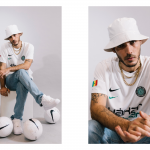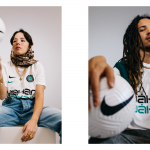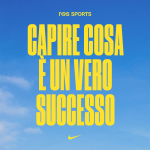
Yakar Project, the humanitarian project that connects Dakar and Paris fashion
Jonathan Szwarc told us what football means in Senegal
January 29th, 2021
The translation of "hope" in Wolof, the mother tongue of Senegal, is Yakar. It's one of the first things that Jonathan Szwarc learned, falling in love with the eyes with which the 500 children of the ADE school in Thiaroye looked at football shirts and balls. His visit in 2015 pushed him to create the Yakar Project, a project whose first goal was to give football shirts to children and which over the years has set a new goal: to donate a football pitch to a Senegalese area in great difficulty. Football at the center of the future of children is the mission of Jonathan and the Yakar team, people who try every day to involve as many people as possible, also leveraging a relevant lifestyle component.
Nike supported Jonathan and his project, helping to give 500 jerseys to the children of Thiaroye, shirts that will be put on sale in a limited edition (150 available on Pro Direct Soccer) to raise funds and improve the school's sports facilities. The date chosen for the launch is next February 15, when a documentary will also be published in which the life, difficulties and love for football of the children of Senegal will be narrated. We chatted with Jonathan, who told us about his adventure and his documentary, the importance of a new and fresh approach to involve the greatest number of people as well as a brand and his future dreams.
Titling a project "Yakar" (hope) says it all about the mission. How did this desire to give hope to the children of the ADE school in Thiaroye come about?
I deeply believe that it is essential to help one's neighbor by choosing the prism that best suits us. For my part, the two causes that are closest to me are youth and football. I was convinced that I could create a unique project for these children through sport, improve their daily life by responding to the lack of material that I had noticed in 2015. Also through the documentary, I wanted to highlight this school and its director who is a real hero in the shadows.
Finally, my desire was also to bring a new facet to humanitarian projects: we can serve a cause that is dear to us while presenting it to the world in a creative way to make an impact and engage as many people as possible.
I am not afraid to say that I want to create a true Yakar brand, distinct, recognizable, whose purpose is to help children through sport. Why couldn't non-profits be as inspiring as Apple or Nike? This is my goal and I think I laid the first brick with these jerseys. The most important thing for me is to think about how we want to help. There are 1000 reasons to do so. I was convinced that I could bring a concrete help and present it in a different way thanks to my vision, my personal experience and my contacts.
Thinking about humanitarian/social aid for disadvantaged children and immediately connecting them to football is an extraordinary thing. What is the relationship between Senegalese children and sport and how can football be an aspect of life that can improve their situation?
The relationship that children, girls and boys, have with football is indescribable. This is what the documentary tries to highlight. Football has an enormous short-term power over the daily lives of children. Indeed, football is not only a way of getting their families out of poverty. The goal of playing is to forget their daily and school difficulties.
In a situation like covid, where the children were not able to go to school for almost 8 months, their only occupation was football. It has kept the children occupied throughout the pandemic. Football also has an impact on the people close to these children. First and foremost their parents, who are reassured when their children play. They know that they are not on the street doing bad stuff.
Finally, football is a formidable tool for the teachers, because it allows them to create a complicity that is often impossible to create in classrooms that are often too crawded. This complicity allows teachers to better transmit knowledge over the years.
One of the results of the project will be a documentary - it will be published on Youtube and on the IGTV of the Yakar Project account - on the life of these 500 children and their relationship with sport. Is there an anecdote or a story that struck you the most among those that were shot? Without spoilers, of course.
Without a doubt, the most striking anecdote for me is the meeting with Selly Sagna, a young 14-year-old basketball player who was interviewed for the documentary. Selly explained to us that she wants to change the mentality of women in Senegal. She confidently said that if women had not gone to school, the country would surely not have progressed as it has today. She now wants women to move past the main cliché related to sport: that of it being reserved for men. They need to listen to their hearts. If they want to play basketball, football, karate, then they have to do it.
The boost that Nike gives to the project - in terms of production and visibility - is certainly an important plus. How does such a brand approach a project that deals with such delicate issues? Obviously Nike works a lot on projects for the less favored and more unfortunate classes. How did the Swoosh approach Yakar and what is he giving to the project?
I had the chance to do a one-year internship during my studies at Nike Football France. Many of my friends who were part of that internship with me are now managers at Nike. It is thanks to them that I was able to enter into discussions with the Swoosh. It was necessary to present a coherent and structured project with a real objective: that of serving Senegalese children through the prism of those jerseys. I also think that my approach of bringing a lifestyle side to a humanitarian project resonated with the brand.
I have to say that the Nike Football France team was clever in the way they accompanied me on this project. They helped me on the production side but left me completely free to orchestrate the project, choose the talents and create the documentary. Nike was a material support and allowed me to boost my visibility without neglecting it.
However, the teams have always put Yakar in the foreground, even giving me the opportunity to send jerseys to players under contract with competing brands to promote it. The most important thing was to serve our cause: to give hope to Senegalese children through the prism of sport. I would like to thank the Nike France teams from the bottom of my heart because without them, the project would have taken much longer to see the light of day.
On the shirts that Nike has produced and that will be released simultaneously with the documentary (teaser here) there is an important message: EVERYTHING IS POSSIBLE. We hope it will be possible to build a football pitch and sports facilities for the school, but what would it take to make a better future "possible" for Senegalese children in your opinion?
In my opinion, it is the access to education and sport that will enable these children to live better in the future. The ADE school also stands for Avenir et Développement de l’enfant (Future and Development of the Child). It was created by an incredible person called Djibril Sané who was unable to go to school at a younger age. As he had an uncertain future when he was younger, he now wants to give these children a certain future. Too many Senegalese children still cannot get an education today. This is a huge problem to be solved in Senegal.
Sport has a crucial role in the educational path of these children. I saw it with my own eyes when I went there in 2015.This observation, combined with my deep passion for football, reinforced my decision to use sport to help ADE's children. I knew that since I was going to do things out of passion, the project would hold up and make sense for the 500 children of the school.
The relationship between Senegal and France is very close and the shirt soon arrived in Paris, where it practically becomes a fashion item. We work every day trying to tell the link between the style of football jerseys and the world of fashion. How can a shirt that has such an important social value turn into a fashion?
One of my priorities was to design a jersey that would be a true vector of hope for children, but also a real fashion item. In my opinion, it all comes down to 2 things:
First, the design of this shirt. It was designed for the field but also for the city with simple colours that can be matched with many outfits. For both men and women.
The second key lies in the way you show your jersey to the world: we have done 2 shoots with very different photographers to reach fashion lovers from different universes.
The photograph @BishopNast gave a very streetwear image of the jersey with photos taken with silver film in the suburbs of Paris. It is often said that the suburbs influence Paris and Paris influences the world. We started from the suburbs. The photographer @KarlHab, is used to Paris Fashion Week. He has been shooting fashion shows for 10 years now. So we made the studio shoot more fashion oriented where the models wore the jerseys in city outfits: jeans, Air force, jewelry etc. This shoot allows people to quickly project themselves wearing the jersey.

































